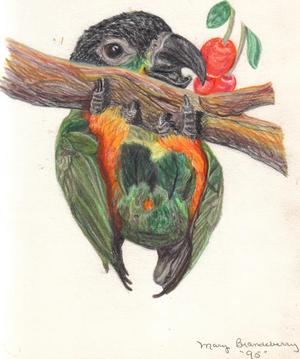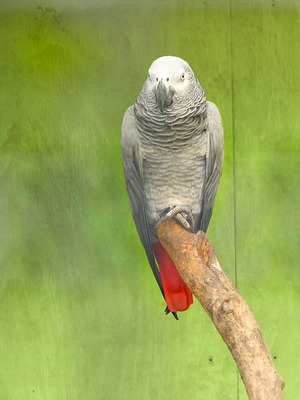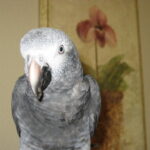There are several types of large parrots available as pets, each with distinctive traits. Which kind you choose is a matter of personal preference, but you should take into consideration suitability and lifestyle before making a purchase. Any parrot you buy will be expensive and may live for decades, so this is not a casual decision.
African Greys are originally from (obviously!) Africa, and are gorgeous, soft grey birds with red tails. They are usually 12′ to 14″ long, and are well known for being prolific talkers. They can range in price from $500 to well over $1,000 depending upon what type of sub-species you choose and where you are purchasing.
It is more important to purchase from a reputable breeder with an African Grey than with perhaps any other type of parrot due to the sensitivity and innate shyness of these birds. A properly socialized, loved bird is essential when purchasing an African Grey.
While African Greys are known as voluble talkers, they are in general quieter than other large birds. That is, they don’t screech as much as some other breeds such as Amazons or Cockatoos. They are excellent mimics, though, and you may be startled to hear them perfectly reproduce the ring tone of your cell phone or the sound of your doorbell or microwave.
Greys can develop an amazing vocabulary and will enjoy talking to their family. How many words they learn and whether they learn to use them intelligently will vary depending upon the temperament and socialization of the individual bird. Greys are not circus performers, however, and are most likely to talk in front of their favorite person or their family or “flock.” They may tolerate speaking in front of guests they know, but will usually be silent in front of strangers.
African Greys have a reputation for being anything from somewhat shy to downright neurotic, depending upon who you talk to. These lovely birds do tend to be more introverted than some others, so be aware that these gentle birds will need a reassuring, calm home life in order to be happiest. They tend to be somewhat nervous and may be more prone to habits such as feather plucking or mutilation than some other types of parrot, especially when faced with change or new situations. Change could mean a new cage, moving to a new home, or a change in family dynamics or routines.
African Greys are best suited to those with relatively stable homes and without small children, since they can be somewhat moody. They are ideal for those who are looking for a highly interactive, intelligent bird that will tend to develop a close bond with one or two special people in the home.
Amazons
Amazons are what most people think of as the traditional “pirate parrot,” with brilliant green body feathers, yellow faces and blue around the beaks with yellow and red shoulder patches. They vary in length from 13″ to 15.” Amazons come from a widespread range in South America, including Brazil, Bolivia, Argentina and Paraguay.
Amazons are the clowns of the parrot world. They love to show off, enjoy talking and are extremely affectionate. They are comfortable with a wide range of environments are adjust more readily than some other breeds of parrots to unusual situations. Because they are so affectionate, you must be sure to interact with them daily and stimulate them mentally in order to avoid behavioral problems over time.
Amazons will, in most cases, go readily to people and aren’t shy about meeting new friends. They will clown about and talk with little or no encouragement and enjoy sitting on shoulders and eating from people’s hands if properly trained. They do, however, have a tendency to vocalize a series of screeches just as they would in the jungle. If you ever hear an Amazon screech, you won’t forget it – it can be ear-piercing!
It is very important to have a high cage for an Amazon, since they are used to the upper canopy of the rainforest. They will also need the opportunity to be free to roam about the house (with wings clipped), but be very careful not to leave windows or doors open to prevent their inadvertently escaping into an environment where they can’t survive.
The diet of an Amazon is similar to that of a Grey – fruits, pellets, vegetables and nuts. They will also enjoy having something to chew on in order to prevent boredom, and will go through toys quickly.
If your family is looking for a fun-loving, happy bird that will chatter and make itself at home in your house, an Amazon may be a good choice. With a life span of 25 to 50 years, they can become a permanent member of your household that will bring you years of laughter.
Cockatoo
Some consider the cockatoo the most elegant parrot species there is. Varying in coloration from a pure white in some sub-species through shades of yellow to the particularly lovely Salmon-Crested Cockatoo, which is a soft apricot shade with a deeper underside. All cockatoos have a crest of feathers on the top of the head which they raise and spread when excited, happy or angry. It’s a sort of “mood ring” for them to indicate that they are emotionally charged.
Cockatoos are in flocks in the wild to a greater extent than most other parrots. Even when adult and mated, they stay in large groups and tend to screech and call to each other on and off all day. These “conversations” are a good indication of what you can expect with a domesticated cockatoo – plenty of vocalization. While most cockatoos do not learn a lot of words, they do produce a distinctively shrill, quivering sound. They can also mimic a variety of sounds in the home such as telephones, dryer buzzers and kitchen timers.
Cockatoos have an insatiable chewing habit, so be aware that you will have to provide wood, and lots of it! Ash and Aspen branches are favorites, but they aren’t so picky that they won’t thoroughly chew up your coffee table or grandma’s rocking chair if the opportunity presents itself. Don’t give them wooden food bowls, or they’ll eat the bowls with their dinner.
Cockatoos have gained popularity recently for their exceptional beauty and striking pastels ranging from buttery yellows to deep pinks and corals. Because the habitat of many types of cockatoos is currently in danger, it is imperative to save these lovely creatures.
Macaws
Macaws are large parrots, achieving sizes ranging anywhere from 24″ to 40″, and can have a wing span of up to four feet. They come in a wide range of color combinations, from the Blue and Gold Macaw to the jewel-toned Hyacinth Macaw. Most Macaws are in the 35″ range, and all are bright and colorful. Prices for these birds are at the high end of the spectrum, with some such as the Hyacinth reaching prices of up to $10,000 for pure bloodlines and the most desirable deep, rich Hyacinth blue color.
Macaws are highly intelligent and enjoy cognitive puzzles. They like to figure things out and will be happiest if they have toys that challenge them mentally and keep them guessing for a while. There are parrot puzzles available that can keep macaws entertained for hours, which is a good idea, since a bored macaw can quickly solve the secret of getting out of a locked cage. These birds are also chewers – they will want to chew on a variety of woods and will need a steady supply. If there isn’t wood available, your furniture can become a prime target.
Swings, ropes and ladders are also essential to keeping the macaw happy. They are acrobatic, active birds who enjoy climbing, swinging, and spinning about. This gives them the opportunity to exercise as well, and these are high energy birds.
All Macaws screech and squawk; these are loud birds. The screaming is a part of their daily routine and is not usually something that can be easily modified as it is with other types of parrots. Most types of Macaws are more adaptable than the average parrot, and they are sociable, curious creatures. There are differences between sub-species, with Scarlet Macaws tending to be a bit more aggressive than some others and Greenwings having a reputation for being quieter. In general, however, the Macaws are not overly sensitive and gregarious birds in most situations.
Lories and Lorikeets
Lorie and Lorikeets are unusual parrots. They feed on pollen, nectar and fruit and have coral-red beaks. These rainbow hued birds are smaller than most other parrots, but still require plenty of room for play and movement. Lories are larger, stockier, and have square tails while lorikeets are slender with long, tapered tails.
Lories are messy birds – because of the high liquid content of their diet, their droppings are very messy and the cage will need cleaned frequently. If you do not have the time to clean up frequently after your Lorie, you will soon have ruined carpet around your cage.
Feeding them is also rather more difficult than with some other birds. They will need liquid nectar, which can be made from commercial mixes or purchased from breeders. These are expensive, but nutritionally complete. You should also add variety to their diet, however, with fruits, vegetables, and weeping willow twigs. To ensure the Lorie doesn’t suffer from a mineral deficiency, add a mineral block to the side of the cage as well.
Wild Lories and lorikeets will often hand upside down while feeding from flowers in their natural habitat, so large cages should hold hanging toys and trapezes. They shouldn’t be left unattended on open stands for long periods because they can hop long distances. You may be startled by where you find your lorikeet when you come back if you leave it out!
Lories must have play time with their owners every day or they will quickly become bored. When with their owners, they will enjoy hanging from them and probing their ears and face with their long tongues. They are demanding of attention and charming. Their affectionate nature and strong bonding to their owners make them cherished companion birds.
In conclusion, there are many types of parrots that are available for parrot lovers. The key in finding the perfect one is to understand the pros and cons of each so that you can make an informed choice based on your unique needs and circumstances.





